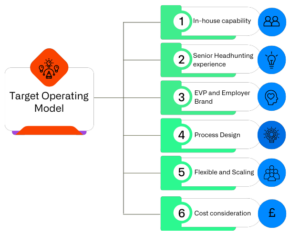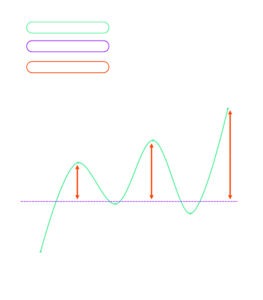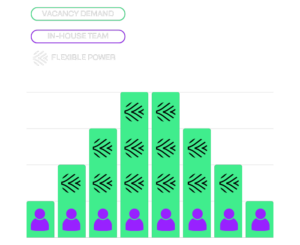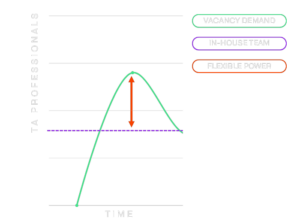The Future Target Operating Model for Talent Acquisition
- Share on LinkedIn
- Share on Twitter
- Copy link Copied to clipboard

The Future Target Operating Model for Talent Acquisition

The Future Target Operating Model for Talent Acquisition
The Talent Acquisition community has experienced a volatile 3 or 4 years to say the least.
There is huge amount of learning for the sector and none more so than looking at the operating models we adopt and how we workforce plan.
TL;DR: Just watch the video
So, what does a target operating model need to include?

All of the above needs to be included in an operating model to develop a world-class hiring environment. The top three areas most teams struggle with the most that require a dedicated focus are:
1) Headhunting Experience & Capability
Often inhouse team may lack the extreme headhunting ability needed to hire in the most competitive niche areas, often they struggle to find the time to focus on engaging passive talent to get enough quality and quantity in the top of the funnel.
2) EVP & Employer Brand
The EVP & Brand maybe weaker than required to compete in the market and lack of ability to influence, control or invest in the brand can be a struggle, often in scale up environments inhouse teams don’t have full time headcount solely focused on EVP & Brand.
3) Flexibility to deal with demand volatility
Lack of flexibility in the target operating model to deal with huge spikes or drops in demand.
Here we focus on how to achieve flexibility and deal with demand volatility which has proven to be the area a lot of businesses still haven’t managed to get right for the last few years.
The problem statement = Demand Volatility
Before we get stuck into what a great operating model looks like for the future it’s important to understand the context of what TA leaders are dealing with. Demand volatility is a rollercoaster in talent acquisition.
TA functions always seem to have either too many roles or not enough roles. Rarely an equilibrium. One consistent pattern we see is that in scale-up environments, they also have almost zero heads-up on the roles before they land which makes it tough to plan effectively.

Green = Hiring Demand
The green curve shows the volatility in demand we have to deal with as TA leaders.
Purple = Inhouse team capacity
The purple line shows the fixed capacity of our inhouse teams.
Red = Flexible power
The Red lines shows the gap between then resource you have in the team and what is required to get the job done. This gap needs to then be filled with some form of flexible power.
What does a good operating model look like?
The core team never changes. (this also means when things are quiet the core team should not be at risk of redundancy either)
You set the in-house team at a demand level where you won’t have to make redundancies. You invest heavily in this team to build exceptional core capability.
- True experts who will develop & protect the employer brand with all they have
- Build clean & scalable processes
- Adopt automation
- Engage key stakeholders
- Have time to support brand via recruitment marketing
Then you plug the gaps with flexible power. Your options:
- RPO
- Agencies
- Embedded Talent Consultancies (the best option of course)

Workforce Planning: Why do we keep getting it so wrong?
The below graph shows one of demand curves and also shows where we keep going wrong.

When we have increased vacancy demand as TA leaders we often end up just moving the purple line up to the top of the demand curve!!!
Or in simple terms we procure the gap with more FTE full-time in-house recruiters on the payroll.
Why do we do this, because it is the cheapest option of course.
However, by the time you mobilise that full-time team the demand spike has often gone or is on the way out and guess what… we start to edge towards redundancy territory because you can guarantee that demand spike will drop at some point. Hiring is usually in peaks and troughs and you don’t want the fixed overheads of a full-time team for those peak hiring periods, you actually need a team to suit the BAU hiring periods.
How can we learn from other business functions?
Look at your Tech functions.
- Do they have 100% FTE headcount on the payroll? Highly unlikely
- Do they procure Tech projects with 100% FTE headcount on the payroll? Nope
- Do they use consultancies, contractors, flexible resource? Yep, everywhere.
Ask yourself & your leaders “what if”?
People will normally gravitate to the cheapest option which is your own FTE headcount. However, this is the slowest to mobilise and riskiest option long term when hiring slows down.
- What if hiring demand drops by 20%?
- What if hiring demand drops by 50%?
- What if we stop hiring all together?
- At what point would we need to make redundancies?
- What if we choose a more flexible route?
- How quickly could we build internal capability that is flexible?
- What is the associated cost of having to make people redundant?
- What is the associated cost of culture damage from a hire and fire culture?
Interested in how Bond could support your business or teams to rebuild your target operating model? Reach out, we’d love to chat with you!
We’ve been there, scaled it across CleanTech, DeepTech and Biotech.

